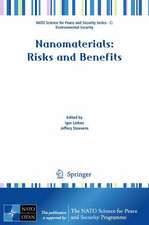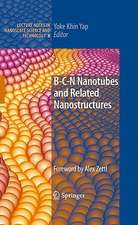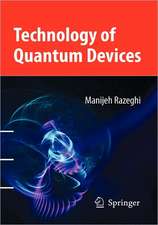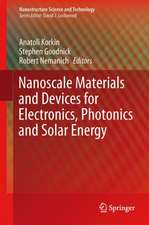Nanostructures and Thin Films for Multifunctional Applications: Technology, Properties and Devices: NanoScience and Technology
Editat de Ion Tiginyanu, Pavel Topala, Veaceslav Ursakien Limba Engleză Hardback – 8 apr 2016
| Toate formatele și edițiile | Preț | Express |
|---|---|---|
| Paperback (1) | 1231.16 lei 43-57 zile | |
| Springer International Publishing – 25 apr 2018 | 1231.16 lei 43-57 zile | |
| Hardback (1) | 1237.48 lei 43-57 zile | |
| Springer International Publishing – 8 apr 2016 | 1237.48 lei 43-57 zile |
Din seria NanoScience and Technology
- 24%
 Preț: 905.77 lei
Preț: 905.77 lei - 18%
 Preț: 1123.35 lei
Preț: 1123.35 lei - 18%
 Preț: 964.71 lei
Preț: 964.71 lei - 18%
 Preț: 1121.76 lei
Preț: 1121.76 lei - 15%
 Preț: 655.60 lei
Preț: 655.60 lei - 18%
 Preț: 1390.11 lei
Preț: 1390.11 lei - 18%
 Preț: 954.31 lei
Preț: 954.31 lei - 15%
 Preț: 645.79 lei
Preț: 645.79 lei - 18%
 Preț: 953.03 lei
Preț: 953.03 lei - 18%
 Preț: 945.79 lei
Preț: 945.79 lei - 15%
 Preț: 639.90 lei
Preț: 639.90 lei - 18%
 Preț: 1109.16 lei
Preț: 1109.16 lei - 23%
 Preț: 779.85 lei
Preț: 779.85 lei - 18%
 Preț: 944.99 lei
Preț: 944.99 lei - 18%
 Preț: 957.62 lei
Preț: 957.62 lei - 18%
 Preț: 971.01 lei
Preț: 971.01 lei - 18%
 Preț: 1232.26 lei
Preț: 1232.26 lei - 18%
 Preț: 960.30 lei
Preț: 960.30 lei - 15%
 Preț: 646.62 lei
Preț: 646.62 lei - 18%
 Preț: 1249.31 lei
Preț: 1249.31 lei - 15%
 Preț: 636.80 lei
Preț: 636.80 lei - 18%
 Preț: 1232.26 lei
Preț: 1232.26 lei - 24%
 Preț: 821.40 lei
Preț: 821.40 lei - 18%
 Preț: 948.92 lei
Preț: 948.92 lei - 24%
 Preț: 1827.86 lei
Preț: 1827.86 lei - 18%
 Preț: 951.91 lei
Preț: 951.91 lei - 24%
 Preț: 794.19 lei
Preț: 794.19 lei - 18%
 Preț: 953.03 lei
Preț: 953.03 lei - 23%
 Preț: 782.54 lei
Preț: 782.54 lei - 18%
 Preț: 952.57 lei
Preț: 952.57 lei - 18%
 Preț: 948.16 lei
Preț: 948.16 lei - 18%
 Preț: 954.93 lei
Preț: 954.93 lei - 24%
 Preț: 809.39 lei
Preț: 809.39 lei - 23%
 Preț: 781.22 lei
Preț: 781.22 lei - 18%
 Preț: 954.93 lei
Preț: 954.93 lei - 18%
 Preț: 1830.34 lei
Preț: 1830.34 lei - 15%
 Preț: 641.71 lei
Preț: 641.71 lei - 18%
 Preț: 1228.96 lei
Preț: 1228.96 lei - 18%
 Preț: 1120.37 lei
Preț: 1120.37 lei - 18%
 Preț: 956.81 lei
Preț: 956.81 lei - 15%
 Preț: 592.59 lei
Preț: 592.59 lei - 18%
 Preț: 953.65 lei
Preț: 953.65 lei - 18%
 Preț: 954.62 lei
Preț: 954.62 lei - 18%
 Preț: 955.25 lei
Preț: 955.25 lei - 18%
 Preț: 959.19 lei
Preț: 959.19 lei - 18%
 Preț: 953.35 lei
Preț: 953.35 lei - 18%
 Preț: 786.84 lei
Preț: 786.84 lei
Preț: 1237.48 lei
Preț vechi: 1509.12 lei
-18% Nou
Puncte Express: 1856
Preț estimativ în valută:
236.79€ • 247.89$ • 195.93£
236.79€ • 247.89$ • 195.93£
Carte tipărită la comandă
Livrare economică 07-21 aprilie
Preluare comenzi: 021 569.72.76
Specificații
ISBN-13: 9783319301976
ISBN-10: 3319301977
Pagini: 550
Ilustrații: XXIV, 576 p. 364 illus., 296 illus. in color.
Dimensiuni: 155 x 235 x 33 mm
Greutate: 1.01 kg
Ediția:1st ed. 2016
Editura: Springer International Publishing
Colecția Springer
Seria NanoScience and Technology
Locul publicării:Cham, Switzerland
ISBN-10: 3319301977
Pagini: 550
Ilustrații: XXIV, 576 p. 364 illus., 296 illus. in color.
Dimensiuni: 155 x 235 x 33 mm
Greutate: 1.01 kg
Ediția:1st ed. 2016
Editura: Springer International Publishing
Colecția Springer
Seria NanoScience and Technology
Locul publicării:Cham, Switzerland
Cuprins
The study of thin films by electrochemical impedancespectroscopy.- Nanometer oxide and hydroxide pelliclesby applying electrical discharges inimpulse (EDI).- Graphite films deposited on metal surface by electricaldischarge pulse.- Structural and physical properties of ZnSxSe1-xthin films.- Thin-film photovoltaic devices based on A2B6compounds.- Theory of the anisotropic magnetoelectric effects inmetglas-piezocrystal laminates.- Experimental studies of the direct andconverse magnetoelectric effects in metglas-piezocrystal laminates.- Particularitiesof physical properties of semimagnetic semiconductors and their practicalapplication.- Cobalt/cobaltoxide exchange bias system for diluted ferromagneticalloy films in superconducting spin-valves.- Local ordering at the interface of the TiO2-WO3bi-layers.- Crystalline structure and surface morphology ofAIIIBVI type lamellar semiconductor nanocompositesobtained by heat treatment in Cd andZn vapor.- Optical and photoelectrical properties of GaS, GaSe, GaTe and InSe semiconductorsand nanocomposites obtained by heat treatment in Cd and Zn vapor.- Photoluminescence of nanocomposites obtained by heattreatment of GaS, GaSe, GaTe and InSe single crystals in Cd and Zn vapor.- Nanoreliefsobtained by various manufacturing methods.- Template assisted formation ofmetal nanotubes.- Thermal conductivity of segmentednanowires.- THz devices based on carbonnanomaterials.- Abrasive flow machining.
Notă biografică
Ion Tiginyanu received his M.S. degree from theMoscow Institute of Physics and Engineering in 1978. He received his Ph.D.degree in Semiconductor Physics from Lebedev Institute of Physics, Academy ofSciences of U.S.S.R., in 1982, and his Doctor habilitate degree in 1991 fromthe Institute of Applied Physics of the Academy of Sciences of Moldova. Hebecame full professor in 1993 at the Technical University of Moldova. From 1984to 1998 he worked as senior researcher at the Institute of Applied Physics ofthe Academy of Sciences of Moldova. In 1998 he joined the Technical Universityof Moldova, being appointed vice-Rector, while in October 2004 he was electedvice-president of the Academy of Sciences of Moldova. He serves as Director ofthe National Center for Materials Study and Testing and Professor at the Chairof Microelectronics of the Technical University of Moldova. In 1995–96 and1998-99 he has been a visiting professor at the Institute of High-FrequencyElectronics of the Technical University Darmstadt, Germany, while in 2001 - atthe Department of Electrical Engineering and Computer Science of the Universityof Michigan, USA. In March 2013 he was elected first vice-president of theAcademy of Sciences of Moldova. Professor Tiginyanu’s research interests arerelated to nanotechnologies, 3D hybrid nanomaterials, ultrathin membranes,photonic crystals, random lasing, cost-effective solar cells and new sensortechnologies. He has more than 300 journal publications and 52 technologicalpatents, and edited 5 books in English. His personal Hirsch index equals 31. In 2011 he got the ‘Outstanding Inventor’ Award from the World Intellectual PropertyOrganization. Along with this, over the last decade he received 17 Gold and Silver Awards at the International Exhibition “Eureka” (Brussels),International Exhibition of Inventions in Geneva and at the InternationalExhibition of Inventions and New Products in Pittsburgh (USA). He is member oftheAcademy of Sciences of Moldova, Honorary member of the Academy of RomanianScientists (AOSR), senior member of SPIE, and member of the AmericanAssociation for the Advancement of Science, IEEE, Optical Society of America,Materials Research Society and Electrochemical Society. He is a Honorary Doctor ofthe Joint Institute for Nuclear Research (Dubna, Russian Federation). He has about 300scientific journal publications, 5 books in English and 52technological patents. He got about 2900 citations to published papers (excludingself-citations) and has a Hirsch index: h = 31.
Pavel Topala received his M.S. degree from the BaltiState University in 1980, his Ph.D. degree in Engineering from Politehnica University of Bucharest,Romania in 1993, andhis Doctor habilitate degree from the Technical University of Moldova in 2008. He became full professor in 2009 atthe Balti State University, Republic of Moldova. In the period from 1982 to 1984,and from 1994 to 2009 he worked as lecturer, associate professor, and head of the TechnologicalDepartment at the BaltiState University. Since2010 he serves as dean of the Department of Exact,Economic and Environmental Sciences at the same university. He is also the headof the scientific laboratory „Micro- and nano-technologies”, head of the Interuniversity Center „Resonancenano-technologies”, member of the National Council of Accreditation andAttestation of the Republic of Moldova, head of subsidiary of the internationalassociation ModTech and Romanian Association for Non-conventional Technologies.He has been an invited professor at the University of Tokyo, Japan; at the University“A. I. Cuza” and University “Gh. Asachi” of Iasi, Romania; at the SilesianTechnological University of Gliwice, Poland and University of Aveiro, Portugal.Professor Topala’s researchinterests are related to nanotechnologies, electric discharge machining, electro-erosionprocessing, plasma physics, coatings consisting of graphite and oxidenano-structures on metal surfaces. He is author of 5 monographs, more than 200journal publications and 9 technological patents. He got 15 gold and silver awardsat international exhibitions of inventions.
Veaceslav Ursaki received his M.S. degree fromthe Moscow Institute of Physics and Engineering in 1979 and his Ph.D. degree inSemiconductor Physics from Lebedev Institute of Physics, Academy of Sciences ofU.S.S.R., in 1985. He received his Doctor habilitate degree in 1998 from theInstitute of Applied Physics of the Academy of Sciences of Moldova. From 1986to 2013 he worked as senior, leading, and principal researcher, consecutively,at the Institute of Applied Physics of the Academy of Sciences of Moldova. Since2013 he serves as coordinator of the Department of Engineering andTechnological Sciences of the Academy of Sciences of Moldova. He has been avisiting scientist at the TechnicalUniversity Athens, Greece in 1996-1997; atthe Technical University Darmstadt, Germany in 1998; and at the Max-PlanckInstitute for Solid State Research, Stuttgart, Germany in 2001. Doctor Ursaki’sresearch interests are related to pressure induced phase transitions in ternaryand multinary compounds, materials science (III-V, II-VI and ternary compounds,radiation-hard materials, nanostructured materials and nanocomposites),electrical, optical and photoelectrical characterization of semiconductormaterials and device structures, lasing effects in solid-state nanostructures,optoelectronic and photonic properties of nanostructures and nanocompositematerials. He has published more than 200 papers in Scopus database and 5 bookchapters. He edited 3 books in English and has 30 technological patents. Hispersonal Hirsch index equals 25. He wonthe Prize of the Academies of Sciences of Ukraine, Belarus and Moldova in 2013.He contributed to the realization of more than 10 international projects,including FP-7 MOLD-ERA Project in 2010-2013.
Veaceslav Ursaki received his M.S. degree fromthe Moscow Institute of Physics and Engineering in 1979 and his Ph.D. degree inSemiconductor Physics from Lebedev Institute of Physics, Academy of Sciences ofU.S.S.R., in 1985. He received his Doctor habilitate degree in 1998 from theInstitute of Applied Physics of the Academy of Sciences of Moldova. From 1986to 2013 he worked as senior, leading, and principal researcher, consecutively,at the Institute of Applied Physics of the Academy of Sciences of Moldova. Since2013 he serves as coordinator of the Department of Engineering andTechnological Sciences of the Academy of Sciences of Moldova. He has been avisiting scientist at the TechnicalUniversity Athens, Greece in 1996-1997; atthe Technical University Darmstadt, Germany in 1998; and at the Max-PlanckInstitute for Solid State Research, Stuttgart, Germany in 2001. Doctor Ursaki’sresearch interests are related to pressure induced phase transitions in ternaryand multinary compounds, materials science (III-V, II-VI and ternary compounds,radiation-hard materials, nanostructured materials and nanocomposites),electrical, optical and photoelectrical characterization of semiconductormaterials and device structures, lasing effects in solid-state nanostructures,optoelectronic and photonic properties of nanostructures and nanocompositematerials. He has published more than 200 papers in Scopus database and 5 bookchapters. He edited 3 books in English and has 30 technological patents. Hispersonal Hirsch index equals 25. He wonthe Prize of the Academies of Sciences of Ukraine, Belarus and Moldova in 2013.He contributed to the realization of more than 10 international projects,including FP-7 MOLD-ERA Project in 2010-2013.
Textul de pe ultima copertă
This bookis focused on recent advances in the development of thin films for photovoltaicapplications, TiO2/WO3 bi-layers for applications with enhanced photo-catalyticproperties, nanometer oxide and hydroxide films for anticorrosive coatings,surface passivation in chemical industries, micro- and nanoelectronics,trilayers of metglas and lead free piezoelectrics for magnetic field sensors,current sensors, spintronics, microwave and read/write devices. Dilutedferromagnetic alloy films are also considered for superconducting spintronicsbased on superconducting spin-valves. Thermal properties of segmented nanowiresare analyzed with respect to thermoelectric applications. Recent advances intemplate production of nanocomposites are also reviewed with particular focuson technologies for template assisted formation of metal nanotubes. Someelements related to abrasive flow machining (AFM), specifically state of theart elements of technological systems and construction of equipment arepresented. The book is written for researchers in materials science,nanotechnologies, PhD students and graduate student.
Caracteristici
Highlights recent advances in the development of thin films, nanostructured and nanocomposite materials types of sensors, transducers, optoelectronic, thermoelectric, photonic, spintronic, microwave and THz devices Gives information about the development of two-dimensional carbon nanomaterials Elucidates the prospects for covering the famous THz gap Includes supplementary material: sn.pub/extras





















